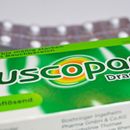Is Vomex A only for humans?
Vomex A, often shortened to "Vomex", is a proven medication for humans that has worked reliably and quickly against nausea and vomiting for generations, regardless of the cause. If your dog suffers from nausea, Vomex A - although originally developed for human medicine - can also be a helpful solution, it just doesn't work as well in dogs as it does in humans. In addition, the vet should be consulted beforehand.
When can I give my dog Vomex A?
Similar to humans, Vomex A is mainly used to relieve nausea in dogs. Nausea in dogs can have many causes, including motion sickness, indigestion or side effects of other medications.
Vomex A is particularly recommended for long car journeys where your dog is prone to travel sickness, as the cause of the nausea is known. However, Vomex is not suitable for the sole treatment of nausea. In addition, intensive training is often the better choice for short car journeys, as Vomex takes around 15 to 30 minutes to take effect and often makes the dog sleepy.
Nevertheless, it is important to use Vomex responsibly . Despite its good tolerability, undesirable side effects can occur. Therefore, you should only give the medication to your dog after consulting a vet.
When should Vomex A not be used?
As it is not an official veterinary medicine, there are no official situations in which Vomex A must not be used. However, there are a few general rules.
Vomex A should not be given to a dog that has already had an allergic reaction to it. Vomex A should also only be given to very small dogs, puppies, senior citizens and sick animals as well as those with kidney or liver problems after explicit consultation with the vet.

Active ingredient dimenhydrinate
The active ingredient in Vomex A, dimenhydrinate, works by blocking certain histamine receptors, particularly those in the vomiting center of the brain, which reduces nausea and makes your dog feel better. It also has a calming effect. This is particularly useful for motion sickness, as many dogs suffer not only from nausea, but also from restlessness or anxiety.
Ingredients of dimenhydrinate
Dimenhydrinate is actually a salt consisting of two components: Diphenhydramine and 8-chlorotheophylline. Diphenhydramine is an anti-nausea and anti-vomiting agent that also has a calming effect. 8-chlorotheophylline is a mild stimulant that helps to reduce fatigue. This combination ensures that you suffer less from nausea.
Administration and dosage of Vomex A
The correct dosage of Vomex depends on your dog's weight. A rough guideline is: 4-8 mg dimenhydrinate per kilogram of body weight.
Vomex A is available in different forms to meet different needs. There are coated tablets with a dosage of 50 mg, prolonged-release capsules with 150 mg, a syrup with a concentration of 3.3 mg/ml, suppositories with dosages of 40 mg, 70 mg and 150 mg and injection solutions with concentrations of 6.2 mg/ml and 50 mg/ml.
Side effects
As with any medication, Vomex A can also trigger an allergic reaction.
The side effects of dimenhydrinate, the active ingredient in Vomex A, occur mainly due to its anticholinergic effects on the central and peripheral nervous system. In humans, common side effects, especially at the beginning of treatment, are drowsiness, dizziness, headache and muscle weakness. These symptoms may still be noticeable the following day. Although these side effects are described in humans, in some cases they can also occur in dogs.
Is Vomex A useful?
Vomex A can help. However, it is important to note that it is not as effective in dogs as it is in humans. It will also make your four-legged friend tired.
Alternatives to Vomex A
There are several useful alternatives to Vomex A for the treatment of nausea in dogs. Depending on the reason for the nausea, one or the other tip will be more helpful. Here are some of them:
Cerenia (Maropitant): This vet-approved medication is specifically designed to treat motion sickness in dogs. It blocks the receptors in the brain that trigger vomiting.
Meclizine: An antihistamine used to treat motion sickness. It has a less sedating effect than dimenhydrinate and can therefore be a good alternative.
Ginger: Ginger is a natural remedy that helps with travel sickness in some dogs. It can be administered in the form of capsules, powder or fresh ginger, but should be discussed with a vet beforehand.
Acupuncture or acupressure: These alternative treatments can help to relieve travel sickness in some dogs. Acupressure bracelets for dogs are also an option to stimulate pressure points that can reduce nausea.
Feeding small, frequent meals before traveling: Smaller meals before traveling can put less strain on your dog's stomach and help prevent nausea. It is also advisable not to feed heavy meals just before traveling.
Take regular breaks during the journey: Frequent breaks to get out and walk can help alleviate the symptoms of travel sickness by allowing your dog to calm down and get some fresh air.
Before using these alternatives, it's important to speak with a veterinarian to find the best and safest option for your dog.
Conclusion on the use of Vomex A in dogs
Vomex A can temporarily help with nausea and vomiting in dogs, especially travel sickness. However, it is not always the best choice as it is designed for humans and can cause side effects such as drowsiness .
A veterinarian should always be consulted before using Vomex A to ensure the best and safest treatment for the dog. Drugs specifically approved for dogs are usually preferable.
Sources and relevant links
Fachinformation
Accessed on 30.07.2024
Vomex.de
Accessed on 30.07.2024
Tackenberg
Accessed on 30.07.2024
Löscher W, Richter A (2016). Lehrbuch der Pharmakologie und Toxikologie für die Veterinärmedizin. 4., vollständig überarbeitete Auflage. Enke Verlag
Kraft W, Emmerich I (2015). Dosierungsvorschläge für Arzneimittel bei Hund und Katze. 6., vollständig aktualisierte und erweiterte Auflage. Schattauer GmbH.
Kohn B, Schwarz G (2017). Praktikum der Hundeklinik. 12., aktualisierte Auflage. Enke Verlag.



















